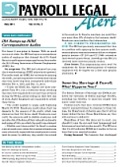The Social Security Administration has announced that the taxable wage base for the Social Security portion of FICA will increase to $128,700 in 2018. That’s a 1.179% hike over the 2017 wage base of $127,200.
The IRS has announced that the amount employees can contribute to their 401(k) and 403(b) plan accounts will increase by $500, to $18,500 for 2018, Employees 50 and older will be able to contribute $6,000 in pretax catch-up contributions, the same as in 2016 and 2017.
2018 Social Security wage base
The 6.2% Social Security tax is payable by both employers and employees; in 2018, the maximum tax is $7,979.40. Except for pretax medical and tax-free fringe benefits, all wages are subject to the 1.45% Medicare portion of FICA, or the 2.35% Medicare portion of FICA for employees earning more than $200,000, since there’s no wage base. (SSA Fact Sheet, 10-13-17)
Exempt amounts for retirees. Retirees who want to return to work are a reliable resource, since they already know the ropes. However, they may lose some of their Social Security benefits. How much they’ll lose depends on an earnings test. Tip: Retirees usually think they’ll lose more benefits than they actually will, so informing them of the 2018 figures can ease their minds.
Retirees who return to work during the year they reach full retirement age—between 65 and 67, depending on when they were born—are subject to a modified earnings test that applies only to earnings for the months before that birthday. Wages earned after that birthday don’t reduce Social Security benefits. For 2018, the exempt amount increases to $45,360 a year; $3,780 a month. For them, $1 in benefits is lost for every $3 they earn.
A separate earnings test applies to early retirees. Employees who retire before they reach full retirement age and who then return to work, can continue to earn up to $17,040 a year, or $1,420 a month, without losing benefits. For these retirees, $1 in benefits is lost for every $2 they earn.
2018 401(k) contribution limits, other fringe benefit limitations
The amount employees can contribution into their 401(k) or 403(b) plan accounts increases by $500, to $18,500 for 2018, the IRS announced. Unchanged from 2017, employees who are at least 50 years old may contribute $6,000 in pretax catch-up contributions.
Other inflation-adjusted amounts for qualified pension plans include the following:
- The Section 415 limit (i.e., the overall pretax, after tax and employer contribution) increases $1,000, to 100% of compensation or $55,000
- The annual compensation limit (i.e., the limit above which contributions can no longer be taken into account increases $5,000, to $275,000
- The dollar limitation concerning the definition of key employee in a top-heavy plan remains $175,000
- The dollar limitation used in the definition of a highly compensated employee remains $120,000. (Notice 2017-64, IRB 2017-45)
Along with the release of the 2018 pension limitations, the IRS also released 2018 inflation-adjusted figures for the following:
- The monthly tax-free reimbursement for qualified employer-provided parking and mass transit benefits increases $5, to $260
- The most employees can defer into their health flexible spending account increases $50, to $2,650
- The salary limit for the 50% small employer health tax credit increases to $26,700, from $26,200. (Rev. Proc. 2017-58)
Still to come
The IRS has not yet released its 2018 Notice 1036, which will address official 2018 withholding allowances and other withholding issues.

